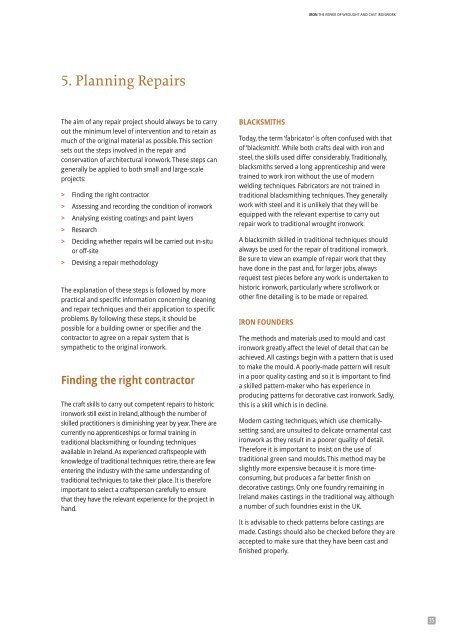The Repair of Wrought and Cast Iron Work - Dublin City Council
The Repair of Wrought and Cast Iron Work - Dublin City Council
The Repair of Wrought and Cast Iron Work - Dublin City Council
You also want an ePaper? Increase the reach of your titles
YUMPU automatically turns print PDFs into web optimized ePapers that Google loves.
IRON THE REPAIR OF WROUGHT AND CAST IRONWORK<br />
5. Planning <strong>Repair</strong>s<br />
<strong>The</strong> aim <strong>of</strong> any repair project should always be to carry<br />
out the minimum level <strong>of</strong> intervention <strong>and</strong> to retain as<br />
much <strong>of</strong> the original material as possible. This section<br />
sets out the steps involved in the repair <strong>and</strong><br />
conservation <strong>of</strong> architectural ironwork. <strong>The</strong>se steps can<br />
generally be applied to both small <strong>and</strong> large-scale<br />
projects:<br />
> Finding the right contractor<br />
> Assessing <strong>and</strong> recording the condition <strong>of</strong> ironwork<br />
> Analysing existing coatings <strong>and</strong> paint layers<br />
> Research<br />
> Deciding whether repairs will be carried out in-situ<br />
or <strong>of</strong>f-site<br />
> Devising a repair methodology<br />
<strong>The</strong> explanation <strong>of</strong> these steps is followed by more<br />
practical <strong>and</strong> specific information concerning cleaning<br />
<strong>and</strong> repair techniques <strong>and</strong> their application to specific<br />
problems. By following these steps, it should be<br />
possible for a building owner or specifier <strong>and</strong> the<br />
contractor to agree on a repair system that is<br />
sympathetic to the original ironwork.<br />
Finding the right contractor<br />
<strong>The</strong> craft skills to carry out competent repairs to historic<br />
ironwork still exist in Irel<strong>and</strong>, although the number <strong>of</strong><br />
skilled practitioners is diminishing year by year. <strong>The</strong>re are<br />
currently no apprenticeships or formal training in<br />
traditional blacksmithing or founding techniques<br />
available in Irel<strong>and</strong>. As experienced craftspeople with<br />
knowledge <strong>of</strong> traditional techniques retire, there are few<br />
entering the industry with the same underst<strong>and</strong>ing <strong>of</strong><br />
traditional techniques to take their place. It is therefore<br />
important to select a craftsperson carefully to ensure<br />
that they have the relevant experience for the project in<br />
h<strong>and</strong>.<br />
BLACKSMITHS<br />
Today, the term ‘fabricator’ is <strong>of</strong>ten confused with that<br />
<strong>of</strong> ‘blacksmith’. While both crafts deal with iron <strong>and</strong><br />
steel, the skills used differ considerably. Traditionally,<br />
blacksmiths served a long apprenticeship <strong>and</strong> were<br />
trained to work iron without the use <strong>of</strong> modern<br />
welding techniques. Fabricators are not trained in<br />
traditional blacksmithing techniques. <strong>The</strong>y generally<br />
work with steel <strong>and</strong> it is unlikely that they will be<br />
equipped with the relevant expertise to carry out<br />
repair work to traditional wrought ironwork.<br />
A blacksmith skilled in traditional techniques should<br />
always be used for the repair <strong>of</strong> traditional ironwork.<br />
Be sure to view an example <strong>of</strong> repair work that they<br />
have done in the past <strong>and</strong>, for larger jobs, always<br />
request test pieces before any work is undertaken to<br />
historic ironwork, particularly where scrollwork or<br />
other fine detailing is to be made or repaired.<br />
IRON FOUNDERS<br />
<strong>The</strong> methods <strong>and</strong> materials used to mould <strong>and</strong> cast<br />
ironwork greatly affect the level <strong>of</strong> detail that can be<br />
achieved. All castings begin with a pattern that is used<br />
to make the mould. A poorly-made pattern will result<br />
in a poor quality casting <strong>and</strong> so it is important to find<br />
a skilled pattern-maker who has experience in<br />
producing patterns for decorative cast ironwork. Sadly,<br />
this is a skill which is in decline.<br />
Modern casting techniques, which use chemicallysetting<br />
s<strong>and</strong>, are unsuited to delicate ornamental cast<br />
ironwork as they result in a poorer quality <strong>of</strong> detail.<br />
<strong>The</strong>refore it is important to insist on the use <strong>of</strong><br />
traditional green s<strong>and</strong> moulds. This method may be<br />
slightly more expensive because it is more timeconsuming,<br />
but produces a far better finish on<br />
decorative castings. Only one foundry remaining in<br />
Irel<strong>and</strong> makes castings in the traditional way, although<br />
a number <strong>of</strong> such foundries exist in the UK.<br />
It is advisable to check patterns before castings are<br />
made. <strong>Cast</strong>ings should also be checked before they are<br />
accepted to make sure that they have been cast <strong>and</strong><br />
finished properly.<br />
35

















